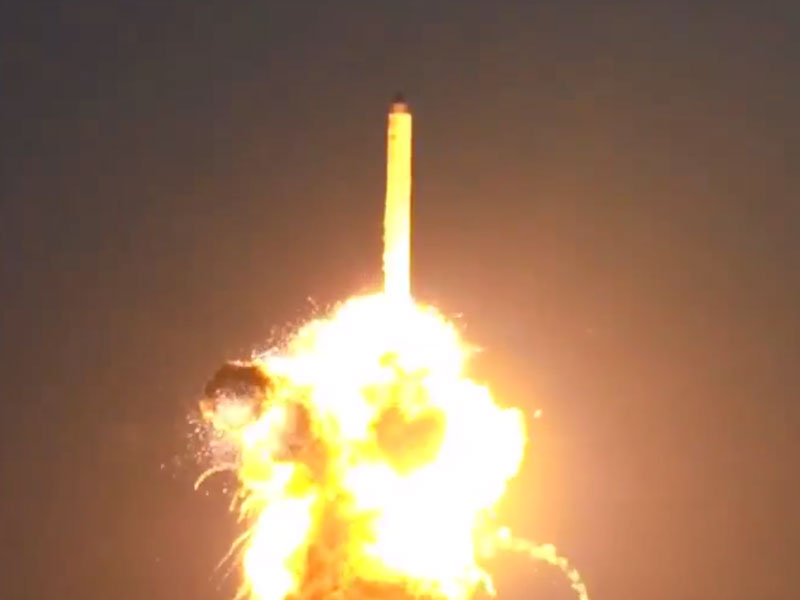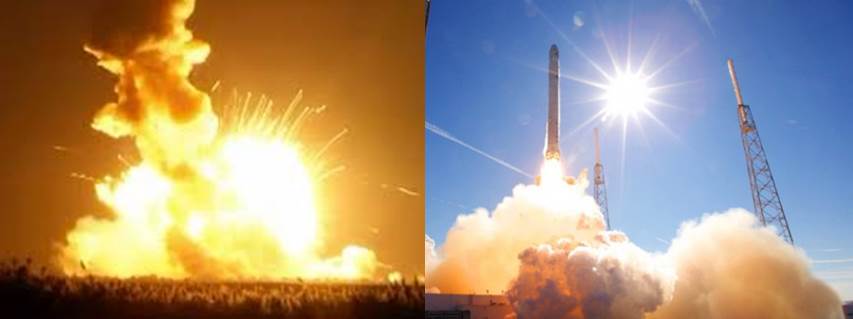October 30, 2014 – Tuesday’s failure of the Orbital Sciences Antares rocket with the Cygnus resupply module and a Planetary Resources satellite aboard paints a sharp contrast with the achievements at SpaceX, Elon Musk’s private rocket company. The Antares rocket, a multi-sourced technology with components coming from the Ukraine, Russia and the United States, blew up a few seconds after launch suffering a “catastrophic failure.”
The Antares’ first stage is built by Yuzhnoe/Yuzhmash in Ukraine. The kerosene and liquid oxygen driven rocket engines come from ND Kuznetsov in Russia. The second stage rockets are from Pratt & Whitney Rocketdyne. Payload fairings and avionics come from Applied Aerospace Structures Corporation of Stockton, California. Orbital Sciences is the assembler of these disparate pieces and although it follows stringent tolerances as defined by NASA, something went terribly wrong. In fairness to Orbital Sciences, the company is just following an old pattern of multiple sourcing components through a bid process, the NASA way. And maybe the wrong way.
In contrast SpaceX is the sole source provider for all the technology built into its Falcon-9 rockets, including its first-stage multiple Merlin engines, the Merlin Vacuum second stage single engine, and all avionics and structural components. It constructs it rocket frame using a unique process invented by the company and designed to reduce weight while strengthening structural integrity.
Similar to Orbital Sciences, SpaceX uses kerosene as its primary propellant. Most of NASA’s rockets these days use much more volatile hydrogen. But unlike Orbital Sciences’ Antares, Falcon rocket technology displays signficant innovation from the ability to do multiple starts and stops, to soft reentry. Not even NASA has perfected the latter. This puts SpaceX ahead in the race to lower the cost of entry to space while maintaining a high level of reliability.
Both companies were contracted to resupply the International Space Station (ISS) with Orbital Sciences receiving $1.9 billion U.S. and SpaceX, $1.6 billion. Orbital Sciences prior to this explosion had demonstrated two successful resupply missions to the ISS delivering supplies using the home grown Cygnus supply capsule. SpaceX on the other hand has also resupplied ISS on four separate missions. Its Dragon supply module is also slated to be used for future human crewed flights to ISS. Dragon has demonstrated an ability to not only deliver supplies but also bring back results of experiments to Earth in water landings. Cygnus, on the other hand, burns up on reentry. Again, SpaceX is demonstrating a far more sophisticated and useful technology.
OrbitalSciences remains under contract to deliver eight resupply missions with its next planned for April 2015 and the last to occur sometime in 2016. SpaceX is also slated to complete its eight resupply missions by 2016.
Elon Musk, SpaceX’s founder questioned the choice of rocket engine technology of his commercial competitor back in a 2012 interview in Wired magazine. He is quoted stating, “their [Orbital Sciences] rocket honestly sounds like the punch line to a joke. It uses Russian rocket engines that were made in the ’60s. I don’t mean their design is from the ’60s—I mean they start with engines that were literally made in the ’60s and, like, packed away in Siberia somewhere.”
Musk is wrong about the date in which the AJ26 rocket engine technology was built. The engine actually dates back to the 1970s for use in a Soviet lunar program that was to rival the U.S. Apollo project, but the engines and rockets they were designed for were never used. When the Soviet Union collapsed the United States purchased a quantity of these mothballed engines for a number of reasons. First, the technology was considered reliable. Second, the price was right, and third, the purchase provided assistance to a Russian space industry reeling from the dismemberment of the Soviet Union government. The engines were then delivered to the U.S. where they were refurbished by Aerojet Rocketdyne, a Pratt Whitney company. Based on the preliminary evidence which is disputed by its original Russian maker,the engines may be a contributing factor in the mission failure. When approached, a ND Kuznetsov spokesperson pointed to the modifications by the American company as being the possible cause.
For Orbital Sciences the explosion calls into question some of their technology acquisition questions. And it will require a thorough review of every component in the Antares rocket and the assembly processes before they will get the green light to fly an ISS resupply mission again. I doubt they will meet their commitment for next May.
Meanwhile at SpaceX, the company keeps forging ahead. Its most recent announcement states that the company intends to start reusing Falcon-9 rockets in missions. For this purpose the company has started construction in Louisiana on a floating platform for landing and reusing Falcon-9 first stages in 2015 missions to the ISS as well as for other contracted flights. SpaceX currently has 12 scheduled for 2015 and believes it has an 80% chance of success in soft landing its first stage with one or more missions.
Another private commercial space venture was a victim of the Tuesday explosion. Planetary Resources, the private asteroid mining company founded by former NASA engineers, XPrize’s Peter Diamandis, Google’s Larry Page, and filmmaker James Cameron, were also impacted by the Antares launchpad explosion. Planetary Resources has plans to launch space telescopes designed to search for suitable asteroids for its space mining venture. The telescopes were to start going up early next year. But a demonstration satellite on board the Cygnus was destroyed in the explosion. The satellite contained the avionics and software for use in the space telescopes and was to be tested in orbit. The company had launched a Kickstarter campaign in part to pay for the mission. Now, its plans too will be delayed.
For Orbital Sciences these next few weeks may prove very difficult as it tries to figure out what caused the Antares’ failure. For SpaceX, Orbital’s failure may prove the efficacy of the former’s decision to begin building rockets in an entirely new way. And for Planetary Resources it means asteroids will have to wait a little longer before they get mined. Nobody said getting to space would be easy.

















